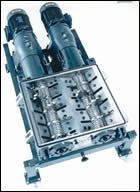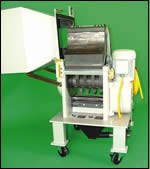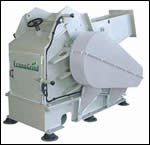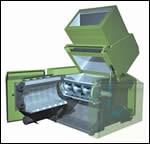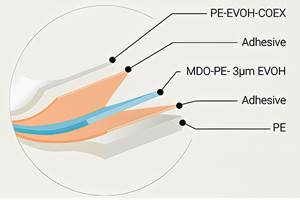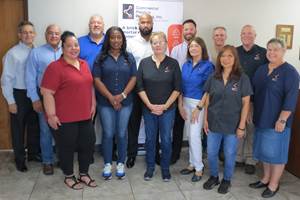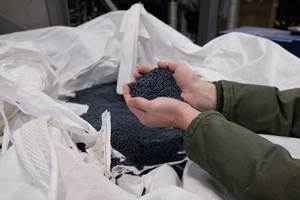New Granulators Galore at NPE
Processors with scrap to grind must have noticed the prominence of screenless granulators with distinctive hooked “S-rotor” blades at the NPE show in Chicago.
Processors with scrap to grind must have noticed the prominence of screenless granulators with distinctive hooked “S-rotor” blades at the NPE show in Chicago. June 23, the day the show opened, was the exact date when the U.S. patent ex pired on Nissui Corp.’s S-Cutter, the original low-speed, S-rotor granulator. That was the green light for an influx of similar granulators from around the world to be shown in the U.S. for the first time.
NPE also played host to many other new granulators, including big central models and beside-the-press grinders with low rpm to keep down dust and noise. New designs also sported larger infeeds, lower infeed heights, interchangeable components, and cutting chambers designed for easier access.
S-blades out in force
Nissui’s Japanese owner patented S-rotor granulators in the mid-1980s. Because the patents did not cover most of Europe or Latin America, other machine builders came out with copies and variations even before the patents expired. Nissui itself has since gone out of business.
S-rotor models exist in single- and twin-rotor versions. What these machines have in common is a chipper rotor with lots of small teeth and a few large, S-shaped blades that intermesh with bed knives. The big S-blades punch out chunks of scrap, which fall down into the bottom of the cutting chamber, where they are nibbled by the small chipper blades. Because the rotors turn slowly (25 to 50 rpm), they reportedly generate less noise and dust than traditional granulators. The disadvantages are that output is low and each rotor produces only one chip size.
One of the new sources of S-rotor granulators here is Moditec of France, represented by Plastec North America. It claims to offer the largest size range—15 single- and multi-shaft models with various shaft widths and numbers of hooked blades, along with a patented serrated cutting blade of its own. Another patented Moditec variation places two non-intermeshing chipper shafts side by side, while a third, “masher” shaft overhead has elongated S hooks to precut large parts like automotive fascias and door panels. The newest feature is the ability to reverse the rotor automatically in case of jams.
Rapid Granulator developed its own line of screenless granulators with help from one of the owners of Moditec, which supplies Rapid with the patented precision cutting components. Rapid’s Multi-Cutter Series comes in three sizes with cutting chambers of 10 x 9.5, 14 x 9.5, and 18 x 9.5 in. They have one to three crusher blades, clear plastic hoppers, and 2.5-hp drives that run at 25 rpm. Conair, a sister company of Rapid, sells the Multi-Cutter as its CM Series.
Cumberland, Ball & Jewell, and AEC supply a screenless granulator of their own design, reportedly the only one on the market with replaceable knives on the chipping rotor, so a whole rotor section doesn’t have to be replaced if a knife breaks. These are the S Series from Cumberland, EX Series from Ball & Jewell, and SX Series from AEC, all with 9 x 9, 9 x 13, and 9 x 18 in. cutting chambers and 2 or 3 hp.
Hamilton Avtec showed new private-labeled S-rotor granulators, the AH Vectra Series, which come in four sizes from 6.6 x 10.5 in. with 2 hp up to 13 x 18 in. with 5 hp.
Shini Plastics Technologies, a unit of Shini Electric Heaters Co. of Taiwan, showed its SG Series screenless granulators, which resemble Rapid’s Multi-Cutter and are built at Shini’s plant in China. They range from a 10 x 7 in. chamber with 1 hp up to 10 x 18 in. with 3 hp. Rapid in Sweden has filed lawsuits in both China and Taiwan protesting the sale of this model with its Moditec-style blade, and Rapid is also suing a European private-label distributor.
Matsui America showed two Chinese-built versions of screenless S-rotor granulators. Model SMGL is a 1-hp model with a conventional top-opening hopper. Model MGL is similar but has an unusual dual-opening clamshell chamber. Matsui will soon offer both in 2- and 3-hp sizes.
SRS Corp. (Size Reduction Specialists) in East Lansing, Mich., continues to build the former Nissui S-Cutter and also owns the rights to the S-Cutter name. Its latest version, the Bi-Cutter, is a patented variation with S-blades on only one of two intermeshing shafts. Another distinction is that the Bi-Cutter rotor is in one piece instead of modular sections. Thus it’s said to hold tight tolerances—down to 0.0005 in.—between shafts and bed knives. Such tight tolerances reportedly make it the only granulator that can chip elastomers.
Wittmann Inc. showed several new models in its Sumo Series of S-rotor granulators, which are built by CMB Wittmann in France. The SJ (Sumo Junior) series has dual rotors and four to six breaker knives. It comes in four sizes, ranging from a 6 x 9 in. cutting chamber and one shaft to an 18 x 20 in. chamber with two shafts. The rotors have trapezoidal cutters on a helical angle, not perpendicular to the rotor axis, making a staggered cut that reportedly uses less energy and is less likely to jam.
Whole new grinder lines
Two entirely new marketing units are offering new lines of imported granulators. EconoGrind USA, part of the new Economizer unit of ACS, offers low-cost granulators built by a German firm at a plant in China. EconoGrind has 20 models in four series: ESL low-speed (150 to 200 rpm), ES heavy-duty, ESP heavy-duty with a special infeed for pipe and profiles, and ESC with tangential feed and soundproofing. They range from the smallest ESL model with a 7 x 5 in. cutting circle up to the biggest ES unit of 32 x 47 in. The ESL series has a V-shaped row of staggered rotor knives.
Gloucester CMG, a new div. of Battenfeld Gloucester Engineering Co., showed its new line of granulators with high-shear, multi-knife cutting chambers and sound enclosures, all built by CMG in Italy. Until last year, CMG built granulators of up to 50 hp under private label for Cumberland. Now CMG supplies its complete range of high-speed (345-rpm) models from 7.5 to 250 hp through Gloucester CMG. The all-new 20-hp model TG 1455U (14 x 55 in. cutting chamber) at the show offers a choice of a three-blade “twin-shear” rotor or 18-blade staggered rotor.
Cumberland now builds all its granulators in South Attleboro, Mass., with solid-steel frames that are doweled and bolted, not cast or welded. Cumberland also has new larger sizes. The 2000 Series central granulators replace the 1828 and 1842 Italian-built models. They have infeeds of 20 x 42, 20 x 50, and 20 x 62 in. as well as a lower infeed height of 63 in. Cumberland’s U.S.-made Tangential Series now accepts larger parts with angled infeeds that measure 20 x 24 and 20 x 36 in.
Wittmann showed the first two of 10 models planned for the new MC Series built by CMB in France. Model MC 2832 has a 27.6 x 31.5 in. cutting chamber and throughput of up to 2200 lb/hr at 400 rpm. The MC 2840 with 27.6 x 39.5 in. cutting chamber has a five-blade open rotor and throughput of 2800 lb/hr at 400 rpm. Both have a new mechanical safety brake.
Interchangeable parts
Two companies showed new models with interchangeable infeeds that convert from tangential to straight. Granutec introduced its Transformer Series with Duo-Pak cutting chambers. It accepts both tangential and straight-drop feed inserts with 16 x 16 to 16 x 32 in. feed throats. Removable cutting-chamber inserts are a solution to high wear from granulating glass-filled and other abrasive materials.
Conair brought out the CW Series central granulator with 18-in. rotor and three interchangeable infeeds. It uses replaceable back plates for tangential feed, restricted tangential feed, and straight drop.
The CW Series also uses a patented new Pivot technology from Rapid Granulator. The front wall of the cutting chamber holds the screen and basket and swings open, leaving the rotor completely accessible from the front or below. The Pivot cutting chamber was also introduced on three new medium-speed Wrath models of central granulators with 18-in.-diam. rotors 24 to 48 in. long.
The big ones get bigger
New Herbold Inc. late last year delivered what is possibly the largest granulator in the world, though two other new models claim the same high output. New Herbold’s model SM 800-2500 was built for a Chinese company to grind PET bottles. It has a 100-in.-wide cutting chamber, 32-in.-diam. rotor, 300-hp drive, and throughput of 10,000 lb/hr at 480 rpm. New Herbold’s biggest unit previously was 62 in. wide and processed 7000 lb/hr.
Getecha introduced its largest granulator to date, which also has a 32-in.-diam. rotor with segmented, staggered blades and a throat 72 in. wide. The RS 8000 series turns at up to 300 rpm, and grinds up to 10,000 lb/hr. Previously, the maximum throughput for Getecha granulators was 6000 lb/hr.
AEC and Ball & Jewell also brought out their largest models so far. AEC’s new ISH Series and Ball & Jewell’s new SSH Series of heavy-duty central granulators have feed openings from 25 x 25 in. up to 73 x 37 in. The biggest in each series has a 32 x 79 in. cutting circle and grinds up to 10,000 lb/hr. A new feature on these models is a deflector wedge, or third bed knife, which is removable for lighter duty grinding of hollow, bulky parts. Also new are a detachable holder for rotor knives and a benchtop fixture to adjust the knives outside the cutting chamber.
Newly redesigned medium-size central granulators from AEC (2200 Series Opti-Angle) and Ball & Jewell (VG2200 Series) have angled cutting chambers designed for all-purpose use at up to 3800 lb/hr. Four chamber sizes range from 22 x 38 to 22 x 66 in. with up to 150 hp. They’re built for easier access and cleaning. Abrasion-resistant packages are a new option.
Two other medium-sized lines were introduced by these firms. The 1200 and 2800 series from AEC and 12 and 28 series from Ball & Jewell each comprise five models from 16 x 12 to 28 x 48 in. feed openings. They have integral soundproofing and easy-opening design. The 12-in. models have integrated blowers and cyclones to discharge granulate.
Weima America Inc., Fort Mill, S.C., showed a patented new granulator-feeding system called CentriCut, which introduces material via an auger into the middle of the cutting chamber. The three rotor blades are attached to the last flights of the auger. The cutting chamber has four bed knives and large screens covering 270° of the cutting circle. CentriCut feeding increases output so much that a 25-hp rotor produces 3300 lb/hr, three times more than a conventional open rotor of the same dimensions, Weima says, and comparable to a 75-hp conventional granulator.
New press-side units
Several companies at NPE launched beside-the-press granulators that run at low speeds to minimize noise and dust. AEC’s new Seven Series and Ball & Jewell’s new 6-1/2 Series run at only 210 rpm. Three models with 6.5 x 8 to 6.5 x 16 in. cutting chambers and up to 5 hp chop up to 200 lb/hr. They have a low feed height of 51 in., self-pretensioning belt drives, and rotating end discs that prevent scrap from wrapping around the ends of the rotor and smearing against the sidewalls.
Conair showed two new beside-the-press series. CLS low-speed models have solid rotors with staggered knives. They run at 160 rpm, grinding up to 300 lb/hr. CHS high-speed versions feature new disposable cassette knives that don’t need costly resharpening. They run at up to 512 rpm for throughputs of up to 800 lb/hr of bigger parts (or film with an optional three-knife helical rotor). CLS and CHS units come in four sizes with 8-in.-diam. rotors up to 24 in. long.
Cumberland’s U.S.-made 1200 Series granulator now offers larger infeed sizes of 12 x 12 to 12 x 20 in. New rotating end discs on the rotor reduce friction of granulate against the chamber walls, producing less heat and abrasion. Cumberland’s 1000 Series also has new rotating end discs.
Granutec showed its Stinger model with a new hopper designed for robotically fed sprues and runners.
Rapid showed off its recently introduced model 1514-CD with an infeed 16 in. off the floor. It is designed for optical-disc molding and fits under the press to save space.
Rapid also added a larger size (8 x 14 in.) of its lower-priced Solo grinder and a larger unit with 8 x 24 in. chamber to its Force low-rpm series.
Low-profile (22 to 23 in. feed height) thermoforming skeleton granulators designed to fit under a trim press were introduced recently by AEC (WG Series) and Ball & Jewell (TG Series). Two models with 36- and 56-in.-long throats have 7.5-hp drives and are said to permit much faster cleaning than previous models.
Related Content
Recycling Terminology Can Be a Minefield, So We Should Tread Lightly
Loose propagation of terms like “recyclable” and “compostable” has already brought down government regulations on labeling. The plastics and packaging industries should take that to heart with other recycle-related language. Like “monomaterial” for example.
Read MoreInside the Florida Recycler Taking on NPE’s 100% Scrap Reuse Goal
Hundreds of tons of demonstration products will be created this week. Commercial Plastics Recycling is striving to recycle ALL of it.
Read MoreScaling Up Sustainable Solutions for Fiber Reinforced Composite Materials
Oak Ridge National Laboratory's Sustainable Manufacturing Technologies Group helps industrial partners tackle the sustainability challenges presented by fiber-reinforced composite materials.
Read MoreNew Facility Refreshes Post-Consumer PP by Washing Out Additives, Contaminants
PureCycle prepares to scale up its novel solvent recycling approach as new facility nears completion.
Read MoreRead Next
Lead the Conversation, Change the Conversation
Coverage of single-use plastics can be both misleading and demoralizing. Here are 10 tips for changing the perception of the plastics industry at your company and in your community.
Read MoreBeyond Prototypes: 8 Ways the Plastics Industry Is Using 3D Printing
Plastics processors are finding applications for 3D printing around the plant and across the supply chain. Here are 8 examples to look for at NPE2024.
Read MoreFor PLASTICS' CEO Seaholm, NPE to Shine Light on Sustainability Successes
With advocacy, communication and sustainability as three main pillars, Seaholm leads a trade association to NPE that ‘is more active today than we have ever been.’
Read More



